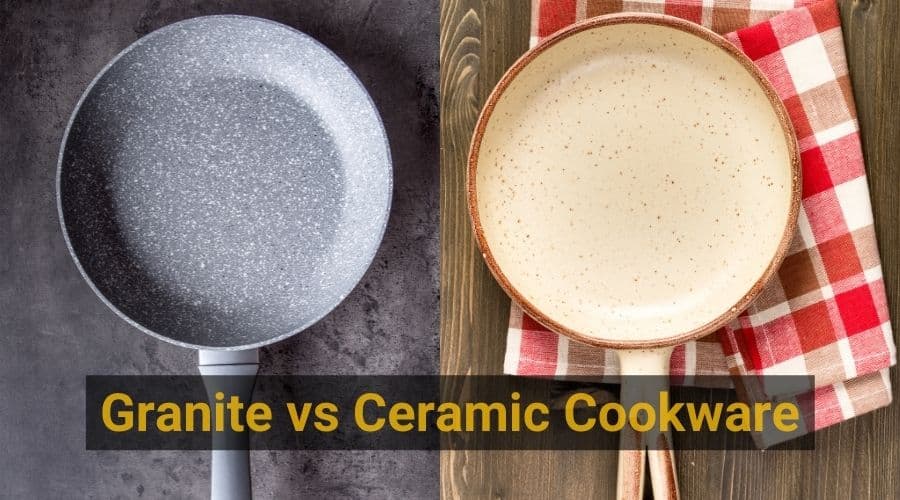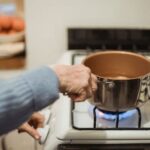Granite Cookware vs Ceramic Cookware

Granite cookware and ceramic cookware are both types of non-stick cookware that are designed to be durable, easy to use, and easy to clean. They are both popular choices for a variety of cooking tasks, including sautéing, frying, and boiling.
However, there are some differences between the two types of cookware that you may want to consider when deciding which one to use:
- Material: Granite cookware is typically made of a heavy-gauge aluminum base coated with a layer of granite-infused non-stick material.
Ceramic cookware is made of a lightweight aluminum base coated with a layer of ceramic non-stick material. - Heat resistance: Granite cookware is generally more heat-resistant than ceramic cookware, as the granite coating is able to withstand higher temperatures without degrading or flaking off. This makes granite cookware a good choice for tasks such as searing meat or stir-frying.
Ceramic cookware, on the other hand, may not be as heat-resistant and may be more prone to scratching or chipping if subjected to high heat. - Non-stick properties: Both granite and ceramic cookware offer good non-stick properties, making them both good choices for tasks such as frying eggs or sautéing vegetables.
However, some users have reported that the non-stick properties of granite cookware tend to last longer than those of ceramic cookware, which may need to be replaced more frequently.
What is granite cookware?
Granite cookware is basically cookware with a granite coating on the surface. It is made up of a carbon steel core which is coated with porcelain enamel.
The carbon steel core makes it more durable and strong whereas the non-sticky porcelain enamel surface helps to cook food in less oil or even without oil.
The cookware doesn’t contain any harmful chemicals and is free from PFOA. So, if you are looking for a healthy and durable cookware set, then granite cookware is the perfect option for you.
Why it is called granite?
This is the fact that it does not contain granite but it got its name granite because of the similarity in their appearance.
Granite cookware has become quite popular in recent years, thanks in part to its ability to distribute heat evenly across the surface of the cookware.
This is a major benefit for home chefs because it means that you will not have to worry about food getting burned or sticking to your pans and pots.
It also makes cooking much easier and more convenient because the even distribution of heat allows for foods to be cooked quickly without burning them.
What are the benefits of using granite cookware?
Non-Stick – The porcelain enamel coating helps to prevent your food from sticking to the surface.
Does not react with acidic foods – It is safe to use and you can cook any type of cooking despite its acidity level as it does not react with acidic food.
Lightweight – The material used for its manufacturing makes it lightweight so it is not heavy like cast iron.
Easy to Clean – It can be easily cleaned and washed as it does not require any special cleaning material or oil to clean it.
Distributes heat evenly – Because of its inner aluminum core, it also distributes heat evenly across the surface of the cookware, which means that you will not have to worry about food getting burned or sticking to your pans and pots.
Non-Toxic – Granite cookware is free from harmful chemicals that why it is known as the healthiest cookware.
Resisting rust – As it is made of stainless steel, it resists rust and corrosion.
Doesn’t Require Seasoning – It doesn’t need any seasoning because of its non-stick surface. So we can say that it is a time-saving cookware as well.
What are the drawbacks of granite cookware?
Expensive – The first drawback of granite cookware is that it can be expensive compared to other types of cookware.
Can’t use on Glass top stoves – Experts say that you should not use granite cookware on glass top stoves because it can damage the surface of the stove. But you can also check the guidelines of Granite Cookware as well.
Requires more care – In order to keep your granite cookware looking its best, you will need to take good care of it.
Thin Layer – As compared to an older version of granite cookware, the newer versions are thinner which results in less heat conduction.
Can’t use Metal Utensils – With granite cookware, you should only use wooden or silicone utensils to avoid scratching the surface.
How to take care of your granite cookware?
Just like any other cookware, you should take care of your granite cookware by following these simple tips:
- Do not use metal utensils on the surface as they can scratch the coating and damage the pan. Use silicone or wooden spatulas instead.
- Do not use high heat to cook food as it can damage the surface.
- Do not pour cold water on a hot pan as it can cause the porcelain enamel to crack. Wait for the pan to cool down before cleaning.
- Clean your granite cookware with warm soapy water and a soft sponge. Rinse and dry thoroughly.
- Safely put it in a dishwasher.
What is Ceramic Cookware?
Basically, there are two types of Ceramic Cookware.
The first one is Solid Ceramic Cookware, also called 100% ceramic cookware, which is made of clay and water and is kiln-baked to harden.
It is dipped to make it non-stick and stain-resistant after the solidifying procedure is completed.
The second one is the most common type of ceramic cookware in which Aluminum is covered with a ceramic coating non-stick surface which is produced from natural sand-derived silicon using a process called sol-gel.
Throughout this article, we will be talking about the second type of ceramic cookware.
Ceramic cookware is a great alternative to traditional nonstick cookware because it is safe and eco-friendly. It’s a good option for anyone who has health concerns or wants an environmentally friendly choice in their kitchen.
Ceramic cookware provides many benefits that make cooking easier and healthier, including being free of chemicals like PFOA, PTFE which are found in other types
Benefits of Ceramic Cookware
Here are some of the top benefits of ceramic cookware.
Non-Reactive – Ceramic cookware is also nonreactive, meaning that it will not interact with the food you’re cooking and will not release any harmful toxins into your food.
Different Color – In ceramic cookware we tend to see a variety of colors and designs. This is a great option for those who want to add some personality to their kitchen or want to find matching cookware pieces with other kitchen appliances.
Lightweight – As compared to other types of cookware, ceramic is much lighter in weight, making it easier to maneuver around the kitchen
Non-Stick – Ceramic coating on the surface provides a nonstick feature that allows food to slide right off after cooking. This means that you can use less oil and butter when cooking your food, resulting in healthier meals for everyone. This also makes it much easier to clean and maintain your pots and pans when you’re done cooking with them.
Heats up Quickly – Another best advantage of ceramic cookware is that it heats up quickly, which means you can cut down on your cooking times and energy costs.
Nontoxic – Ceramic cookware is non-toxic, which means they are free of PFOAs and PFTE. This makes them a safe option for anyone who has health concerns over these chemicals in their cook
Eco-friendly – Ceramic cookware is also eco-friendly and can be recycled. This makes it a great option for those concerned with their environmental impact on the earth.
What are the drawbacks of Ceramic cookware?
Like every other cookware Ceramic cookware is not free of Drawbacks. Let’s have look at some cons so you will be aware of both sides of Ceramic cookware.
Expensive – The first downside of Ceramic cookware is that it can be quite expensive. As compared to traditional nonstick cookware, Ceramic cookware is often more expensive.
Less Durable – Another downside is that Ceramic cookware is counted as fragile material. It’s prone to cracking from heat or dropping on the floor. If you drop a ceramic pan, there is a good chance that it will crack and shatter into pieces. To avoid this you need to be careful when using Ceramic cookware.
Not Dishwasher-Safe – Ceramic cookware is not dishwasher-safe. It requires hand washing with warm soapy water, and it needs to be handled carefully because of the risk of getting scratches on the surface.
Abrasive Scrubs – Although you don’t have to use metal utensils when cooking with a ceramic pan or pot, but you should avoid using abrasive scrubbers and sponges, as these can damage the surface.
Granite Cookware vs Ceramic Cookware: Key Differences
As we have discussed the pros and cons of ceramic and granite cookware. Both are great types of cookware to own, but there are some key differences between granite and ceramic.
Performance
Of course performance of the cookware really matters a lot and performance-wise, both granite and ceramic distribute heat evenly and prevent sticking. They also don’t react with acidic foods as well.
In this regard, both are great choices and hard to say which is better.
Safety
Both granite and ceramic cookware are generally considered to be safe to use, as they do not contain any potentially harmful chemicals such as PTFE (polytetrafluoroethylene) or PFOA (perfluorooctanoic acid).
Design
Granite cookware is a bit thicker and heavier as compared to ceramic. The design of the granite cookware is also quite different with a more traditional style. Ceramics on the other hand often come in fun colors and designs which can be appealing to some people.
Price
The price difference between granite and ceramic cookware is also worth mentioning. Granite cookware can be a bit more expensive, but it can last longer than ceramic as well.
The lifespan of granite cookware can be up to 2-3 years if cared for properly, while ceramic cookware might only last one year.
Verdict
In the end, it really comes down to personal preference when deciding between granite and ceramic cookware.
There is no such thing which is perfect and if it exists then we don’t think without any drawback. So both have their own benefits and drawbacks, so make sure to consider what is important to you before making a decision because your requirements will decide which one to opt.




